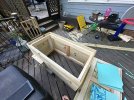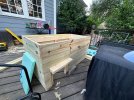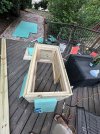LobsterOfJustice
Member
I have built a 2' x 4' outdoor shelter which will be located under our deck (although not up against the house) in our outdoor enclosure. I'm planning on running a Vivarium Electronics radiant heat panel on a VE-200 proportional dimming thermostat. I live in North Carolina, zone 8a which technically means average annual extreme minimum temperature of 10-15* F. Typically, throughout the winter we will get lowest lows around 25 - 35. Rarely lower, often higher (50's). Daytime high temps are almost always above freezing, usually 40s - 50s, sometimes as high as 70s. Pictures of the house structure for reference are below. It has R 7.5 insulation (2 x 3.75) and 3/4" boards on the outside and inside (inside boards not seen in construction pics below). Right now I don't have any plastic curtain over the entrance but I'm considering adding it.
This will be for a Hermann's tortoise. My strategy is to allow the tortoise to brumate, so from what I can tell, I really only need to maintain temps around ~45 *F. However, given that we often have weather much warmer than that throughout the winter, the tort may not be in proper brumation some or all of the time (?). So not sure if I actually need to be targeting a higher temp.
1. In general, is my strategy of RHP + proportional dimming thermostat the preferred path forward?
2. What wattage RHP do I need? They offer 28, 40, 80, and 120. I dont mind getting the biggest one since it will be on a proportional dimmer, just to have the capacity in case I need it (especially in the event that the tortoise "wakes" during a mild week in January and then temps drop again when it is not brumated). Any downside to that strategy?
This will be for a Hermann's tortoise. My strategy is to allow the tortoise to brumate, so from what I can tell, I really only need to maintain temps around ~45 *F. However, given that we often have weather much warmer than that throughout the winter, the tort may not be in proper brumation some or all of the time (?). So not sure if I actually need to be targeting a higher temp.
1. In general, is my strategy of RHP + proportional dimming thermostat the preferred path forward?
2. What wattage RHP do I need? They offer 28, 40, 80, and 120. I dont mind getting the biggest one since it will be on a proportional dimmer, just to have the capacity in case I need it (especially in the event that the tortoise "wakes" during a mild week in January and then temps drop again when it is not brumated). Any downside to that strategy?






